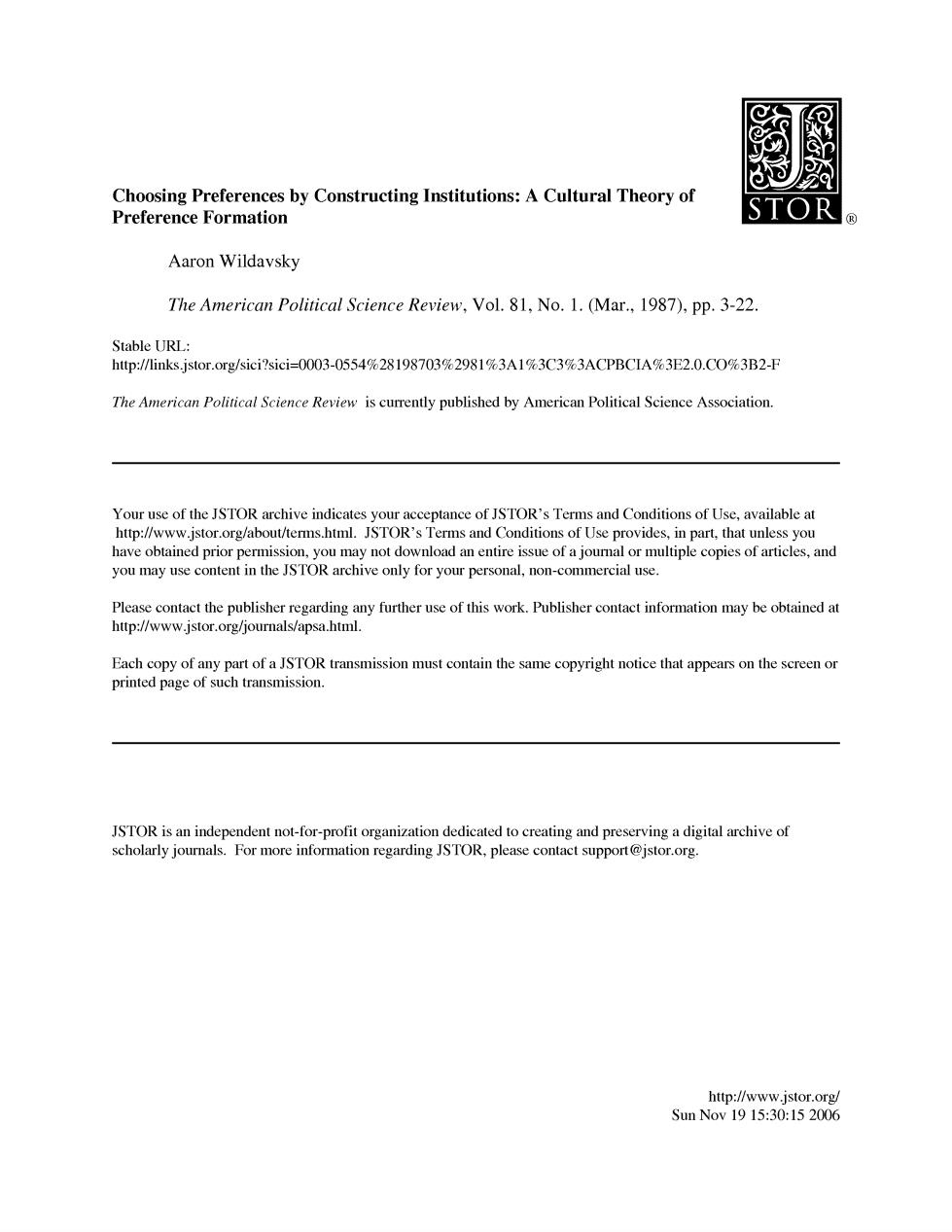
Choosing Preferences by Constructing Institutions:A Cultural Theory of Preference Formation TOR Aaron Wildavsky The American Political Science Review,Vol.81,No.1.(Mar.,1987),pp.3-22. Stable URL: http://links.jstor.org/sici?sici=0003-0554%28198703%2981%3A1%3C3%3ACPBCIA%3E2.0.CO%3B2-F The American Political Science Review is currently published by American Political Science Association. Your use of the JSTOR archive indicates your acceptance of JSTOR's Terms and Conditions of Use,available at http://www.jstor.org/about/terms.html.JSTOR's Terms and Conditions of Use provides,in part,that unless you have obtained prior permission,you may not download an entire issue of a joural or multiple copies of articles,and you may use content in the JSTOR archive only for your personal,non-commercial use. Please contact the publisher regarding any further use of this work.Publisher contact information may be obtained at http://www.jstor.org/journals/apsa.html. Each copy of any part of a JSTOR transmission must contain the same copyright notice that appears on the screen or printed page of such transmission. JSTOR is an independent not-for-profit organization dedicated to creating and preserving a digital archive of scholarly journals.For more information regarding JSTOR,please contact support@jstor.org. http://www.jstor.org/ Sun Nov1915:30:152006
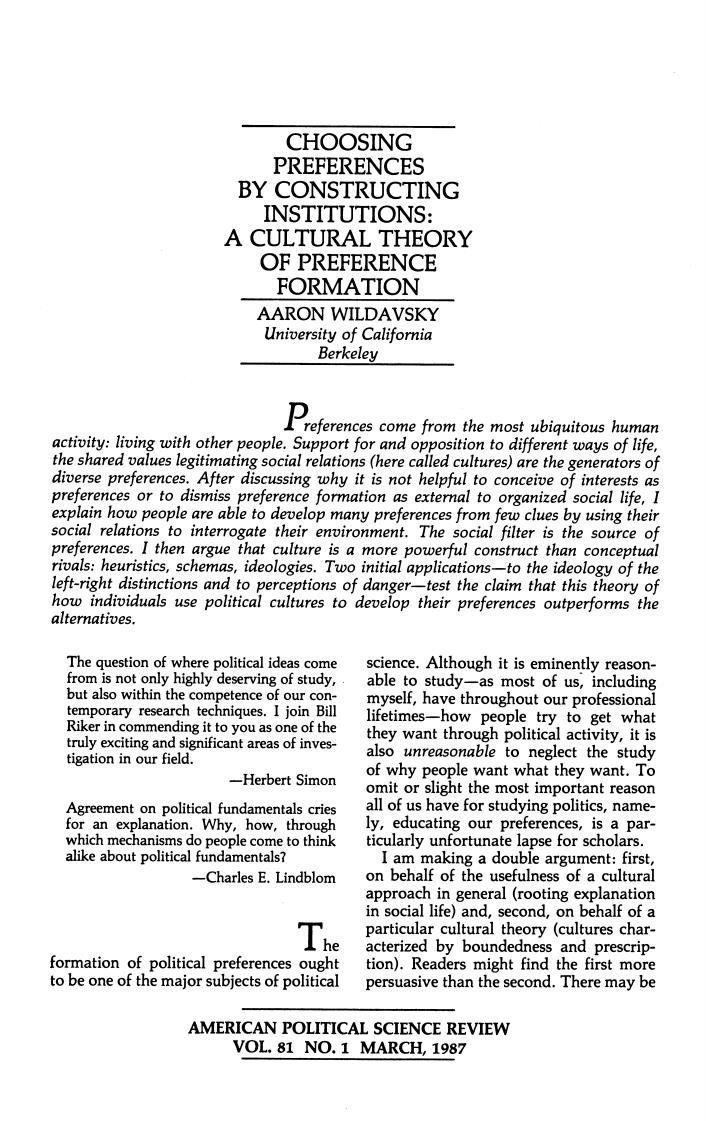
CHOOSING PREFERENCES BY CONSTRUCTING INSTITUTIONS: A CULTURAL THEORY OF PREFERENCE FORMATION AARON WILDAVSKY University of California Berkeley D I references come from the most ubiquitous human activity:living with other people.Support for and opposition to different ways of life, the shared values legitimating social relations (here called cultures)are the generators of diverse preferences.After discussing why it is not helpful to conceive of interests as preferences or to dismiss preference formation as external to organized social life,I explain how people are able to develop many preferences from few clues by using their social relations to interrogate their environment.The social filter is the source of preferences.I then argue that culture is a more powerful construct than conceptual rivals:heuristics,schemas,ideologies.Two initial applications-to the ideology of the left-right distinctions and to perceptions of danger-test the claim that this theory of how individuals use political cultures to develop their preferences outperforms the alternatives. The question of where political ideas come science.Although it is eminently reason- from is not only highly deserving of study, able to study-as most of us,including but also within the competence of our con- myself,have throughout our professional temporary research techniques.I join Bill Riker in commending it to you as one of the lifetimes-how people try to get what truly exciting and significant areas of inves- they want through political activity,it is tigation in our field. also unreasonable to neglect the study -Herbert Simon of why people want what they want.To omit or slight the most important reason Agreement on political fundamentals cries all of us have for studying politics,name- for an explanation.Why,how,through ly,educating our preferences,is a par- which mechanisms do people come to think ticularly unfortunate lapse for scholars. alike about political fundamentals? I am making a double argument:first, -Charles E.Lindblom on behalf of the usefulness of a cultural approach in general(rooting explanation in social life)and,second,on behalf of a The particular cultural theory(cultures char- acterized by boundedness and prescrip- formation of political preferences ought tion).Readers might find the first more to be one of the major subjects of political persuasive than the second.There may be AMERICAN POLITICAL SCIENCE REVIEW VOL.81 NO.1 MARCH,1987
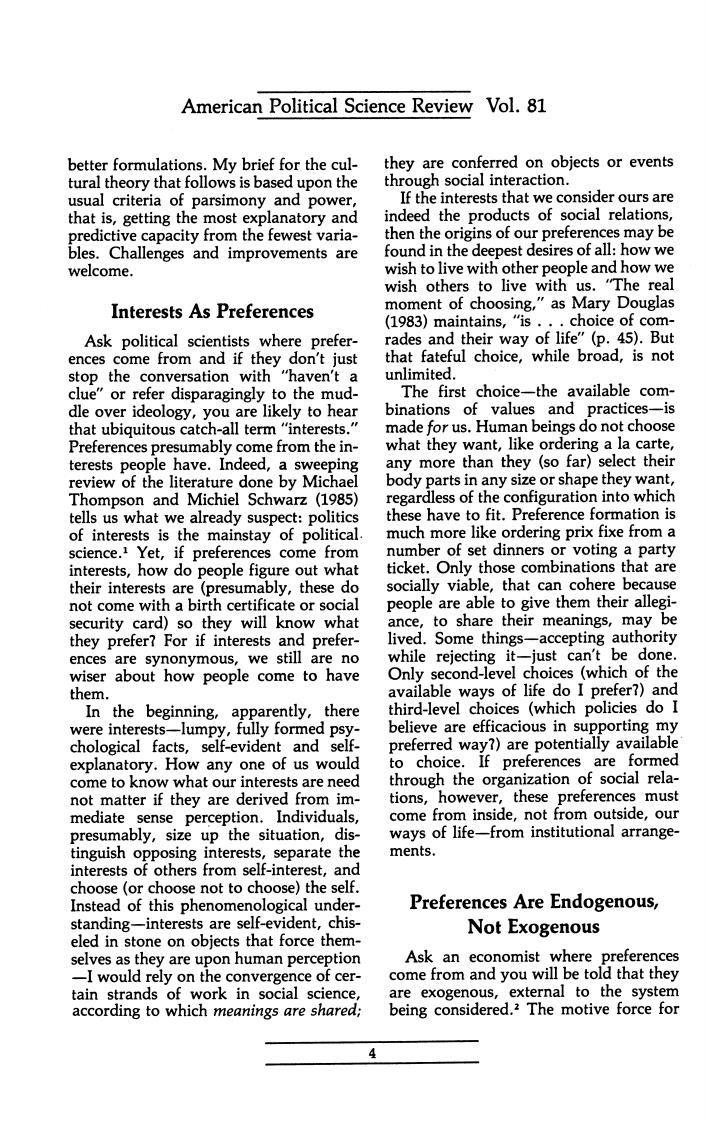
American Political Science Review Vol.81 better formulations.My brief for the cul- they are conferred on objects or events tural theory that follows is based upon the through social interaction. usual criteria of parsimony and power, If the interests that we consider ours are that is,getting the most explanatory and indeed the products of social relations, predictive capacity from the fewest varia- then the origins of our preferences may be bles.Challenges and improvements are found in the deepest desires of all:how we welcome. wish to live with other people and how we wish others to live with us."The real Interests As Preferences moment of choosing,"as Mary Douglas (1983)maintains,"is...choice of com- Ask political scientists where prefer- rades and their way of life"(p.45).But ences come from and if they don't just that fateful choice,while broad,is not stop the conversation with "haven't a unlimited. clue"or refer disparagingly to the mud- The first choice-the available com- dle over ideology,you are likely to hear binations of values and practices-is that ubiquitous catch-all term"interests." made for us.Human beings do not choose Preferences presumably come from the in- what they want,like ordering a la carte, terests people have.Indeed,a sweeping any more than they (so far)select their review of the literature done by Michael body parts in any size or shape they want, Thompson and Michiel Schwarz (1985) regardless of the configuration into which tells us what we already suspect:politics these have to fit.Preference formation is of interests is the mainstay of political. much more like ordering prix fixe from a science.1 Yet,if preferences come from number of set dinners or voting a party interests,how do people figure out what ticket.Only those combinations that are their interests are (presumably,these do socially viable,that can cohere because not come with a birth certificate or social people are able to give them their allegi- security card)so they will know what ance,to share their meanings,may be they prefer?For if interests and prefer- lived.Some things-accepting authority ences are synonymous,we still are no while rejecting it-just can't be done. wiser about how people come to have Only second-level choices (which of the them. available ways of life do I prefer7)and In the beginning,apparently,there third-level choices (which policies do I were interests-lumpy,fully formed psy- believe are efficacious in supporting my chological facts,self-evident and self- preferred way?)are potentially available explanatory.How any one of us would to choice.If preferences are formed come to know what our interests are need through the organization of social rela- not matter if they are derived from im- tions,however,these preferences must mediate sense perception.Individuals, come from inside,not from outside,our presumably,size up the situation,dis- ways of life-from institutional arrange- tinguish opposing interests,separate the ments. interests of others from self-interest,and choose (or choose not to choose)the self. Instead of this phenomenological under- Preferences Are Endogenous, standing-interests are self-evident,chis- Not Exogenous eled in stone on objects that force them- selves as they are upon human perception Ask an economist where preferences -I would rely on the convergence of cer- come from and you will be told that they tain strands of work in social science, are exogenous,external to the system according to which meanings are shared; being considered.2 The motive force for
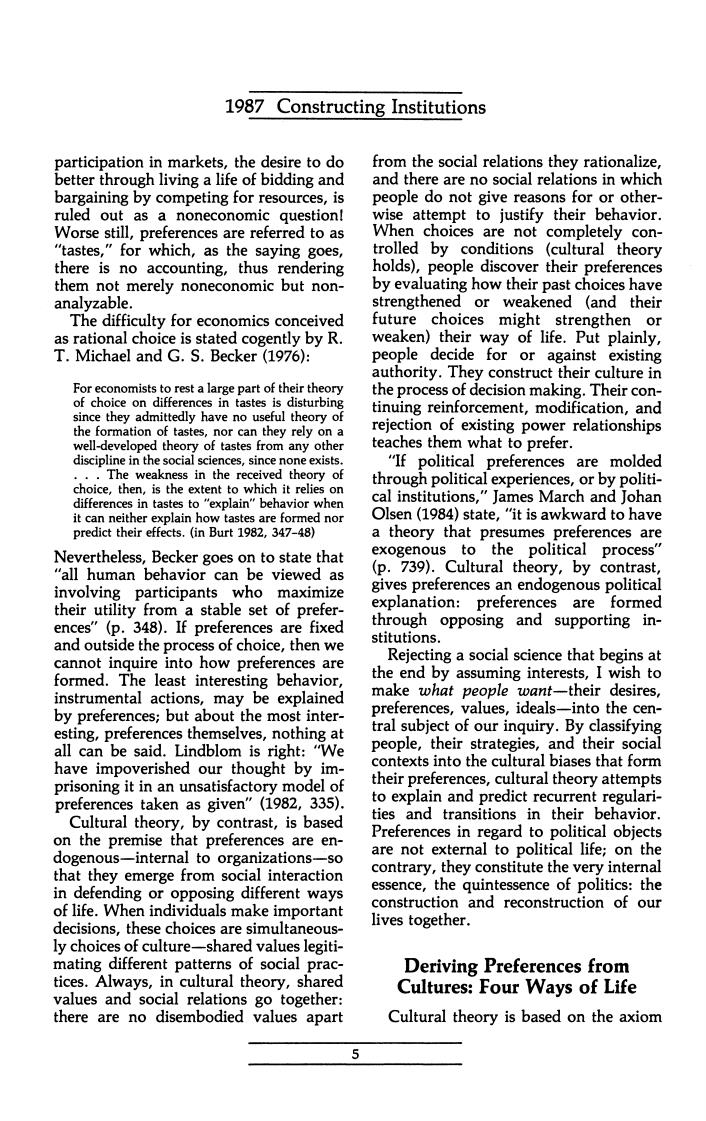
1987 Constructing Institutions participation in markets,the desire to do from the social relations they rationalize, better through living a life of bidding and and there are no social relations in which bargaining by competing for resources,is people do not give reasons for or other- ruled out as a noneconomic question! wise attempt to justify their behavior. Worse still,preferences are referred to as When choices are not completely con- "tastes,"for which,as the saying goes, trolled by conditions (cultural theory there is no accounting,thus rendering holds),people discover their preferences them not merely noneconomic but non- by evaluating how their past choices have analyzable. strengthened or weakened (and their The difficulty for economics conceived future choices might strengthen or as rational choice is stated cogently by R. weaken)their way of life.Put plainly, T.Michael and G.S.Becker(1976): people decide for or against existing authority.They construct their culture in For economists to rest a large part of their theory the process of decision making.Their con- of choice on differences in tastes is disturbing tinuing reinforcement,modification,and since they admittedly have no useful theory of the formation of tastes,nor can they rely on a rejection of existing power relationships well-developed theory of tastes from any other teaches them what to prefer. discipline in the social sciences,since none exists. "If political preferences are molded ..The weakness in the received theory of through political experiences,or by politi- choice,then,is the extent to which it relies on differences in tastes to "explain"behavior when cal institutions,"James March and Johan it can neither explain how tastes are formed nor Olsen(1984)state,"it is awkward to have predict their effects.(in Burt 1982,347-48) a theory that presumes preferences are Nevertheless,Becker goes on to state that exogenous to the political process' "all human behavior can be viewed as (p.739).Cultural theory,by contrast, involving participants who maximize gives preferences an endogenous political their utility from a stable set of prefer- explanation:preferences are formed ences"(p.348).If preferences are fixed through opposing and supporting in- and outside the process of choice,then we stitutions. cannot inquire into how preferences are Rejecting a social science that begins at formed.The least interesting behavior, the end by assuming interests,I wish to instrumental actions,may be explained make what people want-their desires, by preferences;but about the most inter- preferences,values,ideals-into the cen- esting,preferences themselves,nothing at tral subject of our inquiry.By classifying all can be said.Lindblom is right:"We people,their strategies,and their social have impoverished our thought by im- contexts into the cultural biases that form prisoning it in an unsatisfactory model of their preferences,cultural theory attempts preferences taken as given"(1982,335). to explain and predict recurrent regulari- Cultural theory,by contrast,is based ties and transitions in their behavior. on the premise that preferences are en- Preferences in regard to political objects dogenous-internal to organizations-so are not external to political life;on the that they emerge from social interaction contrary,they constitute the very internal in defending or opposing different ways essence,the quintessence of politics:the of life.When individuals make important construction and reconstruction of our decisions,these choices are simultaneous- lives together. ly choices of culture-shared values legiti- mating different patterns of social prac- Deriving Preferences from tices.Always,in cultural theory,shared values and social relations go together: Cultures:Four Ways of Life there are no disembodied values apart Cultural theory is based on the axiom 5
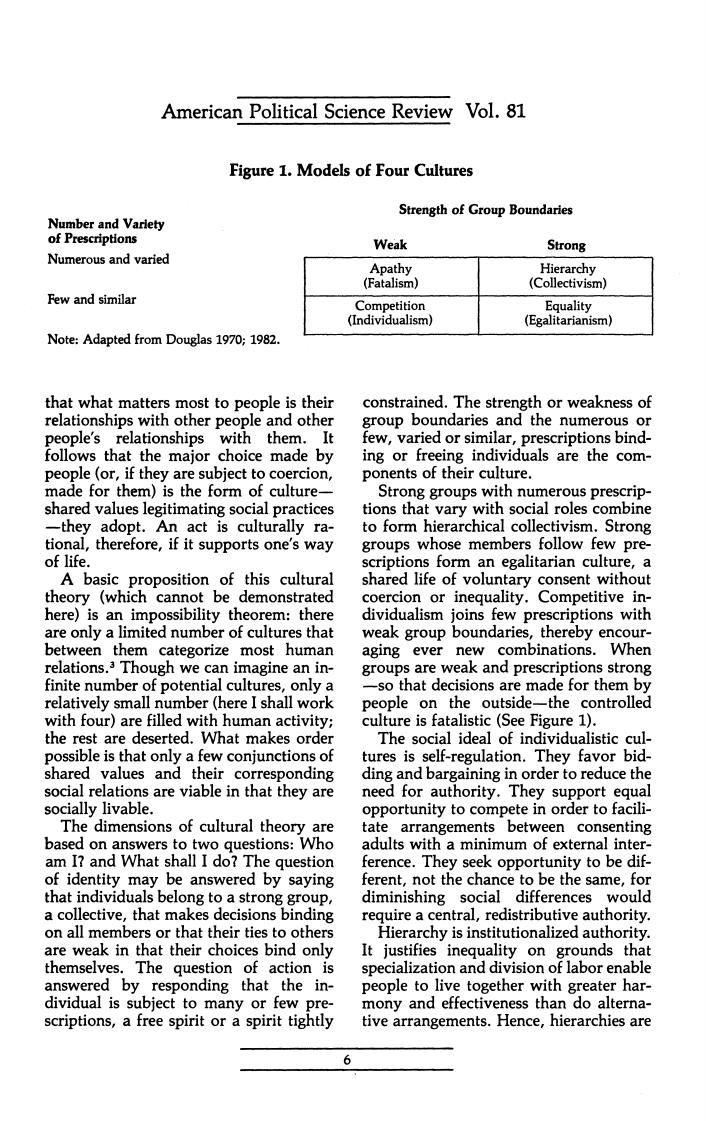
American Political Science Review Vol.81 Figure 1.Models of Four Cultures Strength of Group Boundaries Number and Variety of Prescriptions Weak Strong Numerous and varied Apathy Hierarchy (Fatalism) (Collectivism) Few and similar Competition Equality (Individualism) (Egalitarianism) Note:Adapted from Douglas 1970;1982. that what matters most to people is their constrained.The strength or weakness of relationships with other people and other group boundaries and the numerous or people's relationships with them.It few,varied or similar,prescriptions bind- follows that the major choice made by ing or freeing individuals are the com- people(or,if they are subject to coercion, ponents of their culture. made for them)is the form of culture- Strong groups with numerous prescrip- shared values legitimating social practices tions that vary with social roles combine -they adopt.An act is culturally ra- to form hierarchical collectivism.Strong tional,therefore,if it supports one's way groups whose members follow few pre- of life. scriptions form an egalitarian culture,a A basic proposition of this cultural shared life of voluntary consent without theory (which cannot be demonstrated coercion or inequality.Competitive in- here)is an impossibility theorem:there dividualism joins few prescriptions with are only a limited number of cultures that weak group boundaries,thereby encour- between them categorize most human aging ever new combinations.When relations.3 Though we can imagine an in- groups are weak and prescriptions strong finite number of potential cultures,only a -so that decisions are made for them by relatively small number (here I shall work people on the outside-the controlled with four)are filled with human activity; culture is fatalistic (See Figure 1). the rest are deserted.What makes order The social ideal of individualistic cul- possible is that only a few conjunctions of tures is self-regulation.They favor bid- shared values and their corresponding ding and bargaining in order to reduce the social relations are viable in that they are need for authority.They support equal socially livable. opportunity to compete in order to facili- The dimensions of cultural theory are tate arrangements between consenting based on answers to two questions:Who adults with a minimum of external inter- am I?and What shall I do?The question ference.They seek opportunity to be dif- of identity may be answered by saying ferent,not the chance to be the same,for that individuals belong to a strong group, diminishing social differences would a collective,that makes decisions binding require a central,redistributive authority. on all members or that their ties to others Hierarchy is institutionalized authority. are weak in that their choices bind only It justifies inequality on grounds that themselves.The question of action is specialization and division of labor enable answered by responding that the in- people to live together with greater har- dividual is subject to many or few pre- mony and effectiveness than do alterna- scriptions,a free spirit or a spirit tightly tive arrangements.Hence,hierarchies are 6